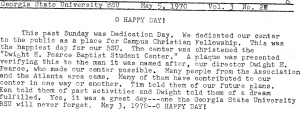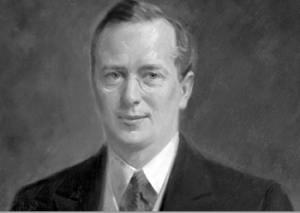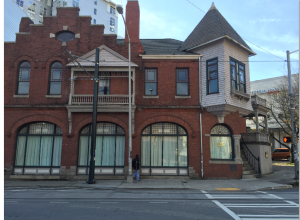Buildings come and go as technology and the world around them change, and in Atlanta this trend is not any different. However, some buildings like the Dixie Coca-Cola Bottling Plant have withstood modernization for almost one hundred and twenty-five years. It’s not the building itself that is important; rather, it’s the history and usage of the building that makes it compelling.

“Sketch depicting the Coca-Cola plant c. 1901.” The Wonderful World of Coca-Cola: Centennial Edition. Nov., 1985:13
The building dates back to 1891, with the exterior remaining true to its original architectural design.[1] During its lifetime, the Dixie Coca-Cola Bottling Plant has lived through three distinct time periods and they are best described in these categories: Shermantown to the founding of the Dixie Coca-Cola Bottling Plant; Early Twentieth Century through the Civil Rights movement; and the Georgia State Baptist Union makeover to present day. During each period of time, the building evolved and was adapted to meet the needs of the changing city around it. It is the survival of modern times that has made the Dixie building an important artifact to the City of Atlanta. But to understand its importance, the history has to be explored.
The Dixie building was built in 1891 at 125 Edgewood Avenue. The building was located in an area known as Shermantown. This settlement was one of the places that freedmen migrated to during the reconstruction of the south following the Civil War. In the article “Hydrology and Residential Segregation in the Postwar South”, it states that “as blacks carved out new life for themselves in the urban core, they often found themselves living in the worst area.” Shermantown was not a great place for people to live, even though its residents were no longer held as slaves. The biggest problem of the area was the lack of a proper water drainage system, so it became a breeding ground for disease among the neighborhoods inhabitants.[2] Though the conditions of Shermantown were not ideal, the door was open for newly freed slaves to develop their own way of life.
Following the Civil War, the city of Atlanta started to see a burst of African American citizens that moved into the city. According to a scholarly article by John Ingham, “by 1870 about half the population was black,” and several African American communities had been developed including Shermantown.[3] The area of Shermantown saw a boom in business, as many of the black entrepreneurs in Atlanta were forced to go the black neighborhoods where they set up their shops for African American consumers. By 1910, the neighborhood where 125 Edgewood Avenue lived had seen over one hundred black owned businesses developed.[4] Shermantown had become a small business center, and this was not going unnoticed by people outside of the community.
At the same time that Shermantown and 125 Edgewood Avenue were booming, so too was the Coca-Cola Company. In 1899, Joseph Whitehead and Benjamin Thomas pitched Coca-Cola owner Asa Candler on how they should have the bottling rights for the soft drink. That was a time where bottling technology was rapidly developing, so putting the popular soft drink in bottles seemed to make sense. Thomas and Whitehead were granted the bottling rights by Candler with no money changing hands. Candler did not expect that bottling soft drinks would become a major industry which was why he agreed to the contract with Whitehead and Thomas, and it was why the contract was very basic.
Whitehead took over the bottling rights in the territory of the south, and with the financial backing of J.T. Lupton they opened up a bottling plant in Atlanta.[5] The plant was set up at 125 Edgewood Avenue, and it was there for the time frame of 1900-01. There is not a great supply of information on why the building was selected, but in looking at the overall history of the area I can reason that the growth of the neighborhood coupled with the proximity to the downtown sector made this site a good place to set up a business in Atlanta. Although the existence of the Coca-Cola Bottling Plant at 125 Edgewood Avenue was brief, the fact that this was one of the original sites for Coca-Cola bottling makes it important to Atlanta’s past. However, I will say that the early history of Shermantown and the struggle for an African American foothold in the urban south made this building more important, even though it is known for being a part of Coke history. 125 Edgewood Avenue did well in its first fifteen years of existence, but it soon faced more challenging times.
In the years that followed the exit of Coca-Cola from 125 Edgewood Avenue, the building fell on hard times. There has been speculation about what happened at 125 Edgewood, as it is believed that it was a “house of ill repute.”[6] But regardless of what people have said about what may have happened, there are two accounts of crimes that took place at the building during the early years of the twentieth century. The first was from October 21, 1906, in which a report stated that police had recently broken up several illegal card games in Atlanta. One of the raids was conducted at 125 Edgewood Avenue, where it was reported that several men had been arrested and that the police “found a regular stud-poker table.” The report painted a grim picture of the area surrounding 125 Edgewood Avenue. The theme of the article was that crime in that area had to be stopped, which is not a big surprise since the Atlanta race riots had happened only a month earlier.[7] The second crime that took place was in 1924, when a woman was shot and killed in front of the store at 125 Edgewood Avenue. The murder was reported on with less of an emphasis on crime being a problem in the area of the building, but 125 Edgewood Avenue was getting in the newspapers for the wrong reasons. The two crimes that took place over a twenty year span may not prove the surrounding area was in bad shape [8], but the building itself had developed a reputation by the later part of the twentieth century.[9] That reputation may have been a bi-product of the crimes that took place at 125 Edgewood Avenue in the years that followed the exit of Coca-Cola.
The run of bad times at 125 Edgewood Avenue would eventually come to a halt, especially as the Civil Rights movement became more prominent in Atlanta. The turning point for the Edgewood/Auburn area came in 1946. That was the year the Georgia white primary law was struck down by the Supreme Court, and in doing so directly affected race relations in the city of Atlanta in a positive way.[10] Atlanta then became recognized nationally as progressive city, as well as a good place to invest money in.[11] The area around 125 Edgewood Avenue, which by the 1960’s had been known as Sweet Auburn due to its successful African American business leaders, showed promise again. For much of the post WW II and Civil Rights era, 125 Edgewood Avenue was a thriving appliance store. The store was known as Brown Radio Sales and Service, but it is unclear whether the owner of the business was African American or of another racial background. The business lasted until the late 1960’s, which was a testament to the area’s thriving commerce sector during the Civil Rights age.[12] 125 Edgewood Avenue found a way to survive the changing landscape of Atlanta in 1950’s and 60’s, and that ability to endure change is another reason why the building has become special to Atlanta. But in the 1970’s, things would change again for 125 Edgewood Avenue.
According to the Georgia State University paper the Signal, 125 Edgewood Avenue was purchased in 1964 by the Atlanta Baptist Association. The tenant, Mr. Brown, was allowed to stay in the building, but he passed away in 1969.

“O Happy Day.” Note May 5, 1970. Baptist Collegiate Ministries website, http://www.bcmgsu.org/history/.
Once that happened, the director of the Georgia State Baptist Student Union, Dwight E. Pierce, convinced the Atlanta Baptist Association to turn the building over to what was then known as Georgia State College. Once the Baptist Association approved, then the Union renovated the downstairs of the building. By 1973, 125 Edgewood Avenue opened for use by the Georgia State Baptist Student Union.[13] The building had again found a way to survive, and it also found a permanent resident. The Baptist Student Union was a good tenant for 125 Edgewood Avenue, and it was fitting that the building became part of Georgia State University as the neighborhood around it had dissolved into the GSU campus. But the building was in rough shape back in 1973, even after the work the students put into it.
By 1983, 125 Edgewood Avenue had survived almost one hundred years of history which included the reconstruction era, the Atlanta Race Riots of 1906, decades of neglect, and finally the Civil Rights age. It had seen so much, but it was falling apart. A building like 125 Edgewood Avenue needed to be protected and preserved, so in 1983 it was designated a National Historic Landmark.[14] This act protected the building from being demolished, but it was still falling apart and needed major renovation. According to the National Historic Landmark Application, 125 Edgewood Avenue is important because it is one of the few original Coca-Cola buildings that still exist. So in 1987-88, the building was restored thanks to the 1987 assessment by the Annual Report to Congress, which deemed the building as a Threatened National Historic Landmark.[15] Even though the building was saved because of its ties to Coca-Cola History, it cannot be considered the only reason why the building is important to Atlanta and the neighborhood it resides in.
The area that 125 Edgewood Avenue is in has gone through many transformations. When the building opened, the area was a haven for freed slaves who tried to rebuild their lives. Because of their perseverance, Shermantown would become a successful place for business. The neighborhood around 125 Edgewood Avenue would go through good and bad times, but it survived for better days much like the slave forefathers did in the generations before the Civil War. Even though the building is recognized for its Coca-Cola influence, I think that it’s a very small part of why this building is important to Atlanta.
The Sweet Auburn area that surrounded 125 Edgewood Avenue has been a big part in the development of African American culture, and this is why the building should be considered sacred. Even though there were no speeches or momentous points of history that took place on the site itself, the building has outlasted time and stands as a reminder of what once was in this area. An indication of how important the building is to the culture and the people of the area is that it’s a part of the Sweet Auburn Freedom Walk. So the next time you walk down Edgewood Avenue and see this funky old building named after the Coke Empire, think of the history of what was there and the purpose the building serves today, and you will see something important.
[1] National Park Service “Dixie Coca-Cola Bottling Plant.” National Park Service, 2015.
[2] Bartow Elmore “Hydrology and Residential Segregation in the Postwar South: An Environmental History of Atlanta, 1865-1895”. The Georgia Historical Quarterly 94.1, 2010: 35.
[3] John N. Ingham “Building Businesses, Creating Communities: Residential Segregation and the Growth of African American Business in Southern Cities, 1880-1915”. The Business History Review 77.4, 2003: 656.
[4] Ingham, 657-658.
[5] Mark Pendergrast For God, Country and Coca-Cola: The Definitive History of the Great American Soft Drink and the Company That Makes It. [2nd ed.]. New York: Basic Books, 2000: 69-76.
[6] Sharon Bailey “GSU Baptist Students Have Hopes to Restore 1891 Victorian Structure.” The Atlanta Constitution Dec. 19, 1982: 43A.
[7] “Is Atlanta Again to Open Doors to the Professional Gamblers Using Queer Cards and Dice?” The Atlanta Constitution, Oct. 21 1906: B1.
[8] “Jealous Lover Kills Woman, and Ends Life; Leaves Death Note Blaming Victim for Deed” The Atlanta Constitution. Aug. 8 1924: 1.
[9] “History.” Baptist Student Union Scrapbook 1971-72, 2015.
[10] Virginia H. Hein “The Image of “A City Too Busy to Hate”: Atlanta in the 1960’s”. Phylon 33.3, 3rd qtr. 1972. Clark Atlanta University: 211-212.
[11] Hein, 207-209.
[12] Display Ad 61—No Title. The Atlanta Constitution, Sept. 30, 1953: 14.
[13] “History.” Baptist Student Union Scrapbook; Jean Driskell “Baptist Student Building Boasts Colorful History.” The Signal, Oct. 18 1973:8.
[14] National Park Service “Dixie Coca-Cola Bottling Plant.” National Park Service, 2015.
[15] National Historic Landmark Nomination. “Dixie Coca-Cola Bottling Plant.” National Park Service, Sept. 15 2003.




